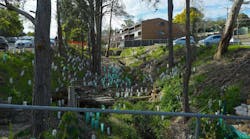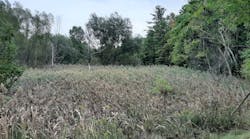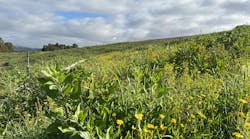“Little by little the sky was darkened by the mixing dust, and the wind felt over the earth, loosened the dust, and carried it away.”
By 1939, when John Steinbeck published those words in The Grapes of Wrath, the Soil Conservation Act was four years old, and the Dust Bowl was an ugly blotch on the nation’s history. Yet, decades later, we still struggle with the effects of wind on soil and the ability of rain to carry dirt and all of the pollutants within it to the sea.
And while economic concerns have been held responsible for destroying the environment, likewise they have burgeoned in response to our fears for it. Controlling erosion has become big business, as vendors compete to stabilize and contain the earth’s treasures.
Seeing a Problem From All Sides
Tom Williams, owner of SiltPros in Woodstock, IL, spends a good deal of his time supervising teams in the field of soil stabilization and runoff management. His background in building and developing has given him a unique understanding of the intricacies of erosion and sediment control. “When I started this business four years ago, I didn’t know enough about erosion control,” he says. “I educated myself and created the company to educate others who were having the same difficulty. I tell the engineers and municipal officers to get out of the office and be creative.”
Williams says his past experience on the buying end has given him an appreciation of the costs involved in controlling runoff. “Especially in this downturn, every penny and dollar counts, and I treat my customers as if we were paying the bill ourselves.”
In the summer of 2008, a mixed-use, 30-acre commercial development in Algonquin, IL, was shut down by the Illinois Environmental Protection Agency. “The dirt contractor was having trouble dewatering the retention pond,” Williams says. “The site was surrounded by wetlands and creeks. We were able to treat the dewatering with a polymer, along with a buffer. We got clean water and were able to discharge into the wetland. With limited space and the cost of land, it is important to use every inch.”
In the same project, Williams used a silt fence, installed with a Silt Fence Installer from Burchland Manufacturing, to stabilize the perimeter of the site. He also uses blankets, hydromulch, granular polymers, run-through broadcasters, and floc logs for short-term stabilization, from 30 to 60 days. “Every project is challenging,” he says.” They all require different techniques and products.”
Williams owns two Burchland silt fence plows. “When I first started this company four years ago, I called Burchland and purchased my first plow. The slicing method with the Burchland plow proved itself the first day we used it. My crew and I probably looked like a bunch of kids with a new toy. Not only has it decreased our installation time, but the fence is more secure than a traditional trench method with minimal ground disturbance. Another feature that a lot of people miss is the flexibility of post spacing. These days we encounter specs with post spacing anywhere from 3-foot to 10-foot centers. With the slicing method versus trenching a preassembled product, we do not have to wait for the supplier to deliver a fence with a specific post spacing; we set it ourselves.”
Pennsylvania’s Clay Soil Poses Problems
Jonathan Hunt is business development manager for River Valley Organics, serving the Greater Harrisburg Region of Pennsylvania. His challenges in that area include steep slopes and what he calls “yellow, shaley clay soil.”
“Closing up” a project and getting the soil stabilized in order to satisfy permit regulations becomes an issue on any construction site. “On one site, there was a major contractor in the area and we needed to get off the permit. The conservation district said, “˜You need to get these channel areas stabilized.’ Nothing grows on that yellow-type soil, and you need 70% minimum vegetation for a permit. These were excavated basins, so you were getting down into the subsoil. The same job site had collector channels, and they asked us to do the same thing with those.”
Using Growing Media supplied by Filtrexx, the developer was able to inject seed into the soil and provide approximately the same stabilization with temporary or permanent cover as would be provided by an erosion blanket, according to Hunt. “It’s a two-for-one deal,” he says. “You get erosion control and permit stabilization. One of the reasons it works in poor soil is that poor soil is delinquent in organic matter. When you get down into the C layer, you don’t have much. With our composted growth media, we add organic material into the soil.”
Hunt says using growth media costs more than hydomulching and straw, but it actually saves money in the end. “If contractors use traditional methods and not enough grows to satisfy the conservation district, then they have to repeat the process, often more than once. Our job is to help the contractor get to the green.”
Filtrexx does the job, according to Hunt, who formerly worked for the conservation district. “We generally can get good results where conventional methods fail.”
Hunt is particularly impressed by the Filtrexx design manual and testing methods. “They do their own testing and use third-party review, such as American Soil and Water, as well as field application testing. Using their manual ensures an excellent probability of success.”
River Valley Organics also did field application testing on the Sediment Trapp from Filtrexx, which can replace the conventional earthwork traps. “Engineers can use Sediment Trapps on the perimeter of an area without disturbing the soil. Earthwork traps are often in people’s backyards and subject to being trampled and run over by bicycles and so forth. Contractors are liable for all of this. They also cut costs because they have a bioinfiltration berm that remains in place, expediting the construction process, because contractors can go to final grade and have permanent stabilization.”
Stabilizing Soil in the Median
The Middle Rio Grande Valley of New Mexico is home to about half the state’s growing population. From its capital, Santa Fe, to its largest city, Albuquerque, there is only one highway, the four-lane I-25 freeway. Congested urban areas and Native American tribal lands restrict roadway expansion. The solution for New Mexico has been a $400 million Rail Runner project, offering light rail commuting at 79 miles per hour.
Kevin Stumpff, president of Windswept Organix in Gilbert, AZ, was active in phase two of Rail Runner, the recently completed extension to Santa Fe, which runs part of its route in the I-25 median. “The project was designed to reduce traffic, increase safety, and limit the effects of travel on the environment,” Stumpff says.
Windswept’s role in the project was to manage the stormwater pollution prevention plan (SWPPP) required by the EPA and the New Mexico Department of Transportation. “We were there from start to finish,” Stumpff says. “We were involved with specifying solutions, designing procedures and plans, installing structural and nonstructural BMPs [best management practices], and maintaining BMPs for stormwater compliance. We also performed the revegetation and final stabilization. We are a single-source solution that takes the not-knowing out of project management.”
Windswept made extensive use of Filtrexx’s FilterSoxx for sediment control throughout the project. “We applied them to the base of slopes, to drainage areas-basically to all water distribution areas to control sediment.”
Stumpff says FilterSoxx offers superior filtration, durability, longevity, and specificity.
“The conventional silt fence becomes a linear dam that ponds water and lets heavy sediment settle. The FilterSoxx acts as a biofilter and lets the water continue to flow. The filter media consists of recycled greenwaste that filters contaminants chemically, physically, and biologically. It lets the water flow and leave the site; it’s not a dam that requires gravity.”
The FilterSoxx is not indestructible, according to Stumpff, but it outlasts its competitors in terms of ultraviolet degradation, important in the sunny West, and for durability. “I’ve seen heavy equipment drive over it,” he says.
Finally, the product uses recycled greenwaste for its filter material. “You can prescribe the contents you want to filter, from hydrocarbons to heavy metals,” Stumpff says.
Rail Runner offered its own challenges unique to its setting. “There were steep slopes and intense traffic,” Stumpff says. “It was built in the middle of I-25 coming out of Albuquerque, and these were highly sensitive environmental areas, with the Rio Grande only five miles from the project.”
The project, highly publicized for the speediness of its four-year construction, presented time constraints to those on the site. “They were continually disturbing new areas while we were closing off other areas for final stabilization,” Stumpff says. “The area was 30 miles long, and there were inspections the whole way. We were protecting old as well as new areas.”
Windswept Organix has its own product, Nature’s Seal, an organic pine resin derivative used to create an emulsion, which is applied to stabilize soil from wind and water erosion. “It can be combined with standard mulches to create a fiber matrix,” Stumpff says. “It can also be blended with compost or mulch and applied for slope stabilization. It is sticky and cures hard, so it can be blended with any aggregate for use on walkways or roadways. The main benefits of Nature’s Seal are that it is 100% natural, and it is not water soluble once cured.”
Stumpff says he uses the product extensively in arid regions like the Southwest where soil needs to be stabilized for air-quality purposes. “We apply it to vacant lots in commercial and housing developments, where not all of the pads have been developed out,” he says.
Economic Downturn Means More Empty Lots
Jack Adcock is development superintendent for Brightleaf at the Park, a community started in 2004 by Rhein Interests of Raleigh, NC. With a target completion date of 2012, the housing development has had a slow start in the economic downturn but is expected to hold 212 homes and 1,780 townhomes when finished.
Vacant land poses both runoff and dust-control problems for any developer. “We have to have ground cover at all times,” Adcock says. “We maintain a seeding regimen of every two weeks.”
Adcock says he has used SiltShield on a few lots to demonstrate to the city and county the product’s filtration, durability, and neatness. “It’s aesthetically pleasing because it is green and matches its background.”
SiltShield’s safety also came up for praise. “It limits the water, but it also has shorter posts than the conventional silt fences,” Adcock says. “It can be driven over and will stand back up because it is not attached to poles.”
The fence comes in several types, but Adcock says the fiberglass model is the sturdiest. “It costs more, but you can remove and reuse it. It is 100% reusable.”
Adcock says both the city and county of Durham are vigilant in monitoring any building site. “Any significant rain event and they come out. We have two creeks running through the project, and they run into the Neuse River Basin.”
Regulatory enforcement has increased greatly in the past few years, according to Adcock. “We have to keep the streets clean and free of mud so that silt doesn’t get into the storm structures. The state and city inspect quarterly and yearly, when it used to be twice a year. If there is a fine, the inspections increase.”
Diversionary ditches, check dams, and straw rolls are among the techniques Adcock uses to stabilize slopes.
But the News Isn’t All Bad
The economic downturn is putting a swing in the step of Bill Milan, corporate vice president of Quik Turf Inc., a hydroseeding contractor from Ocala, FL.
Builders continue to build in north central Florida, but many are unable to sell their proposed lots, according to Milan, who cites a 250-acre development carved out of the side of a hill. “The developer put in the main anchor store and sold the outparcels to various restaurants, but when it came to finishing the project, they couldn’t sell all of the parcels, so they had 18 acres of sand in three stockpiles, with slopes of 80 to 120 feet high,” he says.
When Milan was approached to stabilize the piles, he was told that getting rid of the dirt would cost too much money. “They told me just one of the piles was worth $1.5 million, so we decided to stabilize the piles and grow vegetation on them.”
Erosion control blankets offered an obvious but very expensive choice, so instead Milan’s firm used Profile Products’ Flexterra, a flexible growth medium, on the slopes and Soil Cover 70:30 wood/cellulose mulch on the flat areas. “Flexterra is about one quarter of the price of blankets,” Milan says.
In Florida, native grasses such as Bahia and Bermuda are used so that germination will occur quickly and provide the best coverage. Rye grass, which is a cool-season grass, is used because it will germinate in less than six days and put down quick roots for immediate erosion control, according to Milan. “The developers want the soil stabilized; then, when they’re ready to use the dirt elsewhere, they just dig it out and spread it as they need it.”
An office-building project in Ocala called for 18 buildings, of which only two sold, leaving the developer with 16 bare pads. “We used 70:30 on that area because it was flat,” Milan says.
While building in north central Florida is still steady, according to Milan, there is a glut of houses on the market. In one townhome development scheduled to have 44 homes, only two have been sold, leaving 42 pads and common areas for Quik Turf to protect from erosion.
“We sprayed Flexterra the Sunday before Tropical Storm Fay [in August 2008],” he says. “Andy Constantine of Profile Products and Steve Barr of Pennington Seed-Florida told us it would take two hours to dry. The hurricane arrived on Tuesday, and it rained for five days. We didn’t lose any soil.”
As a licensed and certified stormwater and erosion control inspector, Milan uses his expertise and knowledge to advise and assist contractors in making the right choices. “We don’t want sand going into the roadways and down into the storm drains,” he says, adding that vegetation through hydroseeding is the most economical solution.
Where Erosion Is for the Birds
What is a boy from Wisconsin doing on a cold afternoon in March? He’s down in Florida, sitting outside of his office and listening to birdsong.
Robb Brown, director of Cornerstone Environmental Services in Dade City, FL, has been involved in the environmental side of construction since graduating from college. With a background in environmental studies, he worked for an engineering firm in design development and as a stormwater inspector before doing onsite, hands-on work for Cornerstone. “We handle erosion control from beginning to end in construction projects,” Brown says. “We do our own research on products so that we can make knowledgeable recommendations. We develop and implement SWPPPs, and we work throughout Florida with a wide variety of clients and regulatory agencies.”
Florida’s Department of Environmental Protection (FDEP) works with municipal separate storm sewer systems (MS4s) and with five water management districts that not only administer flood protection programs and perform technical investigations into water resources, but also oversee the design and function of stormwater management systems. The state and the local MS4s implement federal National Pollutant Discharge Elimination System (NPDES) regulations, and all three (FDEP, the MS4s, and the water management districts) have some regulatory jurisdiction over erosion issues.
Florida regulations require inspections weekly and within 24 hours of any half-inch or greater rain event, which keeps them inspecting several days a week. “We have 54.2 inches of rainfall each year,” Brown says, adding that most of it falls in the summer. “We have to work between raindrops.”
The MS4s are stringent in regulating runoff, and the water management districts are stringent in ensuring proper function of the stormwater management systems, according to Brown. “Many MS4s have trained several of their code enforcement and building inspection staff to conduct spontaneous NPDES compliance inspections.”
Brown says Florida’s erosion challenge lies mainly in the variety of its soil. “We run the gamut from flat and sandy to clay soil with slopes and hills.”
Sunset Pointe of KB Home in Clearwater, FL, has about 30 townhome buildings selling from upward of $154,990 per unit. Under construction for the past three years, the site has been the victim of constant traffic in tight areas and consequently a challenge for erosion control. “We tried a half dozen ways to contain the soil near entryways, lot access, and high-traffic areas,” Brown says. “From small berms wrapped in fabric to silt fences to cutbacks at the curb and rock entrances, SiltShield offered the best combination of durability and functionality.”
A SiltShield will last several weeks, and even months, depending on the traffic, Brown says. “You can run over it several times, and it takes accidental or incidental hits in stride. We put it up before a lot pour and it lasts until the landscaping, with maybe one replacement.”
Planning Ahead Pays Off When Weather Turns Nasty
Jonathan Koepke is soil erosion and sediment control division manager for ENCAP LLC, in Sycamore, IL. ENCAP, an ecological firm that addresses water-quality issues on construction sites and natural areas, specializes in consulting and constructing BMPs and in natural area restoration.
In October 2007, a commercial subdivision project in Somers, WI, for Inland Real Estate Development involved six weeks of extensive earthworks, according to Koepke, who says his company did erosion and sediment control inspections, reporting, and BMP installations. On the 117-acre site, contractors excavated 30 feet of fill from a proposed stormwater basin. “It involved a lot of coordination between us and the contractors on soil erosion and sediment control, developing some temporary diversion berms and controlling runoff during the rapid site improvements,” he says.
After approximately 600,000 cubic yards of material had been moved in six weeks, the project was interrupted by November’s inclement weather. “We immediately fell back and started topsoiling the side-slope areas,” Koepke says. “We seeded and put down some heavy erosion control blankets as well as diversion structures to hold the site over the winter.”
Koepke says that planning ahead for such work stoppage is key to any successful operation, focusing not only on stabilization but temporary structures to control runoff.
Yet, when winter weather is a factor, one cannot always foresee every event. “In that January, we had 8 inches of snowmelt, followed by 3 inches of rain and some thunderstorms,” Koepke says. “We had a breach of one of the diversion berms and some erosion down into the sediment basin we had constructed. We used a temporary slope drain on a large 3:1 slope that was approximately 45 feet long. We had to come in with larger diversion and a larger pipe system to carry that water down the slope. The key there was the quick recognition of where the failure was and what had to be put in place to keep the site in compliance.”
Koepke praises Burchland’s Silt Fence Installer for its durability and speed of installation. “It allows us to statically slice the fence into the ground. It opens a narrow slit and the fabric is laid behind it. The tractor then compacts the ground a forms a tight seal. It is embedded into the soil, and two burly guys could not lift it out.”
Koepke says the fence will hold up for one or two seasons in an area where variable weather and highly compacted clay soil makes it difficult to start grading. “It can be 70 degrees here and start snowing the next day.”
Multiple Methods a Must in Solving Problems
Ryan Bright, manager of Soil-Tek in Grimes, IA, does seeding and erosion control on new projects for cities, the Iowa Department of Transportation, cities, and private residential and commercial developers.
A recent project for the city of Independence involved a half-mile to one-mile street extension of Jackson River Drive for Radmacher Bros. Excavating. “The area east of Kansas City has little topsoil; it’s all rock,” Bright says, explaining the difficulty of installing a silt fence in these conditions. For durability and strength, he says the McCormick Silt Fence Plow has no competitors. “It is heavy and well built; one of the few that will hold up when there is rock everywhere.”
Bright says the plow also saves time when compared with a traditional method involving a trencher and manual silt fence installation. “We just did 7,000 feet of fence in a day.”
For a company that covers all aspects of erosion control on a project, having more than one trick up one’s sleeve is a must. Bright has particular fondness for Profile Products’ Flexterra, which he used on the Saylor Creek Project in Ankeny, IA. “We put native seed around manmade lakes in the middle of a residential and commercial development for DRA Properties,” he says. “We sprayed after Thanksgiving, and it sat through the winter and still looks the same.”
Installing what he estimates to be “over a million feet of silt fence a year,” Bright also calls on the Burchland Manufacturing Silt Fence Installer for tight access. “It has an offset that allows us to get closer to, say, a fence or a treeline.”
Ultimately, staying competitive in the field of erosion control means that a company has to offer a wide variety of services and stay current with new products, regulations, and methods.




